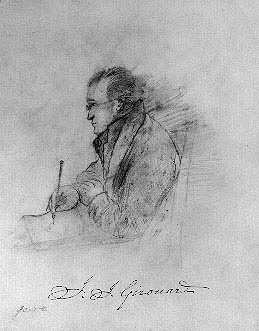

Jean-Joseph Girouard, 1837 - 1838
Artist: Lorimier, François-Marie -Thomas (1803 - 1839)
Medium: Pencil with stumping on heavy wove paper
Dimensions: 23.9 x 20.1 cm
Jean-Joseph Girouard Collection
National Archives of Canada, negative no. C - 133430
The Jean-Joseph Girouard collection documents in a special way one of the most dramatic episodes in the history of our country, the Rebellion of 1837-1838. The patriots, led by Louis-Joseph Papineau, sought to obtain political and economic control of the province.
Of Acadian descent, Girouard was born in Quebec city on November 11, 1795. Thanks to his cousin, Thomas Baillairgé, Jean-Joseph was initiated into drawing, architecture and sculpture. He began to study to be a notary in 1811, interrupted his studies at the time of the war in 1812, and finally finished his clerkship in June 1816. The next month he opened his notary's office in the house of the merchant Jean-Baptiste Dumouchel of Saint-Benoît. On November 23, 1818, he married Marie-Louise Félix.
Girouard's political commitment dates from January 1828, when he became secretary of the constitutional committee of York county. Involved in the constitutional struggle of 1837, he helped draw up the 92 Resolutions and attended meetings across the province. An arrest warrant was issued for him on December 1, 1837, and a reward of 500 pounds ($2000) was offered for his capture. Upon learning of the arrest of his friends the Dumouchels and the Massons, he gave himself up to the authorities, and was imprisoned on December 26, 1837.
Girouard's fist incarceration lasted seven months and during this period he drew portraits of his companions in adversity. The collection includes about 75 portraits that he did at this time, 70 of which were of Patriotes. Girouard was finally freed on July 16, 1838, for bail of 5,000 pounds, subsequent to Lord Durham's amnesty. He was incarcerated again the day after the launching of the armed attack on the patriots, on November 4, 1838. His second stay in prison, which lasted seven weeks, ended on December 27, 1838. The collection includes fifteen portraits of Patriotes that he did during his second imprisonment.
These portraits in pencil, sometimes touched with charcoal, measure about 25 x 20 cm and bear original inscriptions and notes. Girouard used a great variety of paper for his portraits, and was sometimes forced to cut the sheets in two in order to save paper, which was scarce in prison. Holes in varying numbers, probably made with pins, appear at the top of many of the drawings. Certain portraits may have been bound together in the form of a book. Twenty-five of the collection's portraits are on tracing paper. Moreover, some of the holes suggest that the sheets were pinned together to make copies. It is thus possible to imagine that Girouard made duplicates of some portraits, keeping one copy, which has reached us through his descendants, and giving the other to the relatives of the inmates. But, since Girouard never seems to have signed his portraits, only the initiated will be able to recognize them.
After the Rebellion, he left active politics and returned to practice as a notary. His wife died on April 2, 1847, and on April 30, 1851, he married Émilie Berthelot. With his wife's support and with the small indemnity of $3,996 he had received for the losses suffered at Saint-Benoît, he had the Hospice d'Youville built there in 1853. Jean-Joseph Girouard died at Saint-Benoît on September 18, 1855.